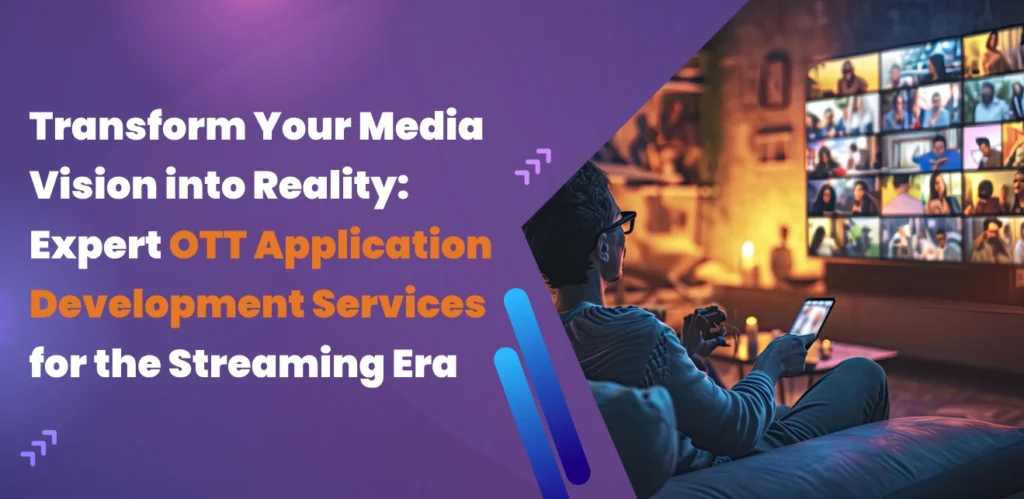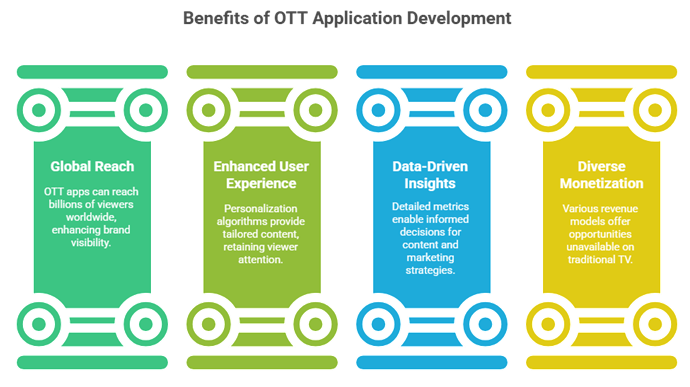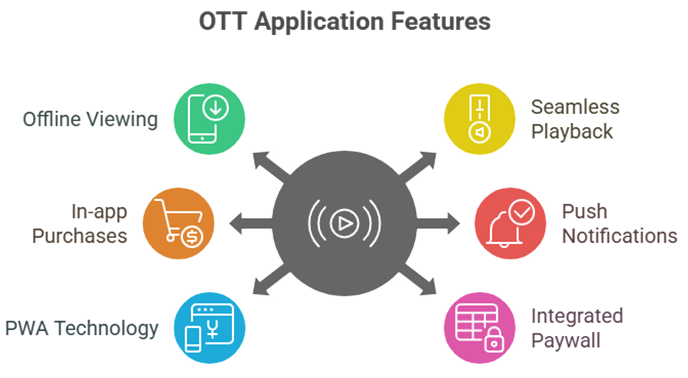
In today’s digital entertainment landscape, Over-The-Top (OTT) applications have revolutionized how we consume media. Gone are the days when viewers would eagerly wait for their favorite TV shows to air at specific times. The shift toward on-demand, personalized content has created tremendous opportunities for businesses looking to enter the streaming market. This comprehensive guide explores OTT application development services and how they can help you create a successful streaming platform in 2025.
Understanding OTT Applications
OTT applications are platforms that deliver video content directly to viewers via the internet, bypassing traditional cable or satellite TV providers. Popular examples include Netflix, Hulu, Amazon Prime Video, and Disney+, which allow users to access vast libraries of movies and TV shows on smart TVs, mobile phones, or computers.
The media and entertainment industry has undergone significant transformation over the past decade, with consumers increasingly demanding fast, personalized streaming experiences. This shift in preference has made OTT channels one of the most dominant forces in entertainment this century.
Key Benefits of OTT Application Development

Global Reach and Audience Expansion
One of the primary advantages of launching an OTT application is the ability to reach a global audience. Unlike traditional broadcasting that requires localization infrastructure, OTT apps can stream content through the internet to any location with a connection. This opens potential access to billions of viewers worldwide, significantly boosting your brand’s visibility and discovery opportunities.
Enhanced User Experience
Modern OTT platforms leverage personalization algorithms powered by machine learning to suggest customized content based on individual user behavior and viewing history. This tailored experience helps retain your audience in a highly competitive market where viewer attention is constantly contested.
Data-Driven Insights
OTT platforms provide valuable viewership data and consumer insights that traditional TV companies could only dream of acquiring. You can collect and analyze detailed metrics on content performance, viewer segments, engagement times, device preferences, and much more. These insights enable highly informed decisions to optimize both content strategy and marketing tactics for maximum ROI.
Diverse Monetization Opportunities
From a revenue perspective, OTT applications offer various monetization models unavailable on traditional TV. These include:
| Monetization Model | Description |
| Subscription Video on Demand (SVOD) | Users pay recurring fees for unlimited access (e.g., Hulu, HBO) |
| Transactional Video on Demand (TVOD) | Pay-per-view or individual content purchases (Ex: Amazon Prime Video) |
| Ad-Supported Video on Demand (AVOD) | Free content with advertisements (e.g., YouTube) |
| Hybrid Model | Combines elements of the above models |
Essential Steps for OTT Application Development
1. Define Your Requirements
Before beginning development, clearly identify what your OTT application needs to accomplish. You have two primary options:
Customize a White-Label Solution: This approach allows you to build upon existing frameworks, applying your brand designs to available programs. It’s typically faster and more cost-effective than building from scratch.
Develop a Custom OTT App: Building from the ground up provides complete control over every aspect of the application. The process involves detailed planning, feature selection, UI design, and back-end infrastructure setup.
2. Establish Your Budget
Setting a realistic budget is crucial for OTT app development. Key cost factors include:
- Development Costs: Developer rates vary based on expertise and location
- Design Expenses: UI/UX design investment for an intuitive user experience
- Content Licensing: Acquiring content rights for your platform
- Maintenance and Updates: Ongoing costs include server hosting, updates, and customer support
3. Focus on UX/UI Design
Your OTT application’s success heavily depends on user experience (UX) and user interface (UI) design. Consider these key aspects:
- User Journey Mapping: Plan the complete user experience from start to finish
- Intuitive Navigation: Create simple, straightforward menus with familiar icons
- Responsive Design: Ensure consistent performance across all devices
- Personalization: Implement features like watchlists and personalized recommendations
- Accessibility: Include subtitles, audio descriptions, and readable fonts
4. Implement Robust Content Management
Proper content management is essential for delivering seamless viewing experiences. This includes:
- Metadata Management: Catalog all content with detailed metadata
- Content Ingestion: Develop streamlined processes for uploading and encoding videos
- Content Delivery Network (CDN): Utilize powerful CDNs to minimize buffering
- Digital Rights Management (DRM): Implement advanced protection against piracy
- Analytics: Track user behavior and content performance
5. Select the Right Technology Stack
Choosing appropriate technologies is crucial for building a scalable, high-performance OTT platform:
Frontend Technologies:
- React Native for cross-platform app development
- Flutter for high performance and rich pre-designed widgets
Backend Technologies:
- Node.js for scalable server-side applications
- Ruby on Rails for rapid development
Database Management:
- MongoDB for handling large volumes of unstructured data
- PostgreSQL for complex queries and transactions
Additional Tools:
- Amazon Web Services for cloud services
- Firebase for backend services including authentication and analytics
6. Implement Multi-layered Security
Protecting your valuable video content is paramount in OTT application development. Industry-leading security protocols help safeguard your content and build trust with your audience. This includes:
- DRM encryption for content protection
- Secure authentication mechanisms
- Anti-piracy measures
- Compliance with industry standards
7. Ensure Multi-device Compatibility
Modern viewers expect to access content across various devices. Your OTT application should provide consistent, high-quality experience on:
- Smart TVs
- Mobile devices (iOS and Android)
- Desktop computers
- Tablets
- Gaming consoles
Advanced Features for Your OTT Application

To stand out in the competitive streaming market, consider implementing these advanced features:
Offline Viewing Capabilities
Allow users to download content for offline viewing, ensuring uninterrupted experiences even without internet connectivity.
Seamless Playback Across Devices
Implement “resume watching” functionality that enables users to continue content from where they left off, regardless of which device they’re using.
In-app Purchase Options
Boost engagement and enhance brand loyalty by offering various in-app purchase options.
Push Notifications
Keep users informed about exclusive content and new releases with concise, targeted notifications.
Progressive Web App (PWA) Technology
Effectively reach users on both web and native apps with PWA technology that ensures seamless offline functionality.
Integrated Paywall Features
Easily manage access to premium content with flexible paywall options.
Choosing the Right OTT Application Development Partner
Selecting the right development partner is crucial for your OTT project’s success. Consider these factors:
Assess Expertise:
- Look for developers with proven track records in OTT application development
- Verify their expertise in your preferred technology stack
Check Communication Practices:
- Ensure they maintain clear, open communication throughout the project
- Assess their project management methodologies
Verify References:
- Read reviews and testimonials from previous clients
- Review detailed case studies of past projects
Evaluate Budget and Timeline Alignment:
- Get detailed cost estimates without hidden fees
- Agree on realistic timelines for project milestones
Conclusion
Developing an OTT application is a complex but rewarding endeavor that requires careful planning, strategic decision-making, and technical expertise. By following the steps outlined in this guide-from defining your specific requirements and setting a realistic budget to designing an intuitive user experience and selecting the right technology stack-you can build a powerful streaming platform that meets your audience’s expectations and stands out in the competitive digital landscape.
Remember that successful OTT application development combines thoughtful planning, innovative technology, and strategic execution. With the right approach and development partner, your streaming platform can achieve significant success in the rapidly evolving world of digital entertainment.